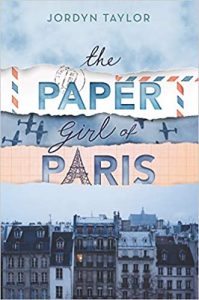My Writing Process Is Like Building a House, I Think
 By: Jordyn Taylor
By: Jordyn Taylor
New York City was in lockdown, and I needed to write something. It was the spring of 2020, and I suddenly had a lot more time on my hands than usual—not to mention anxiety. I decided that throwing myself into a new project—an idea I’d been kicking around for months— would be a great way to fill the time, ground my spiraling thoughts, and maybe get a new book proposal together.
I had an idea in mind, but not a plot. Before I wrote each of my first two books, The Paper Girl of Paris and Don’t Breathe a Word, I created a detailed plan with my narrators’ internal and external journeys mapped out in a four-act structure. This time, I didn’t have the patience. I wanted to go. I opened a new document on my Microsoft Word app and went for a walk (one of my favorite drafting methods, TBH) and I started to write. I let the story flow from my heart through the pads of my thumbs.
I regret to inform you that it was terrible.
There is no correct way to write, but rather loads of styles that work differently for everyone. I’ve learned the strategy that works best for me, personally, is to meticulously plot the whole story before I begin. Otherwise, my characters and scenes feel rudderless. I don’t know what to make them do because I don’t know who they are or where they’re going.
I always compare my writing process to building a house (which is something I’ve never done, but I think I deserve a pass given the sheer amount of HGTV programming I consume on a weekly basis).
The first thing I have to do is construct a stable foundation. I go to a blank page in my notebook and draw thee horizontal lines, dividing the page into four acts. In tiny writing with lots of arrows squiggling all over the place, I flesh out each of the acts, which go roughly like this:
In the first act, there’s an inciting incident, followed by a moment when the main character debates whether or not to embark on their journey (this cues up the central tension, which will ultimately erupt in one way or another at the climax). By the end of the first act, they’ve decided to set off on said journey.
The second act starts with the main character making exciting progress, but ends with a crushing setback—a low point that makes them contemplate abandoning their journey for good.
In the third act, the main character recommits to their cause. The ball is rolling again, this time toward the climax.
The fourth act is the resolution, where the subplots wrap up. I like to throw in one last heartwarming twist for the main character, like a long-awaited kiss. (Maybe this should have come with a spoiler warning for Don’t Breathe a Word…)
My first two novels are both historical fiction with dual narrators—one in the present and one in the past. I created a four-act plan for each of them, side by side; this way, I could make sure their stories intersected at key moments.
Next in my house-building operation, it’s time to turn my rock-solid framework into a functioning abode. In other words, it’s time to write a first draft. As long as I can make time around my day job to write—which, before the pandemic, involved writing on my phone on the subway to and from work—assembling a first draft is fun and fairly easy.
Thanks to my plan, I know what beats to hit, and when. The writing isn’t pretty yet; to quote the feedback a college history professor used to write on my papers, it’s “workmanlike, not graceful.” (Ouch, I know.) But my house is coming along. It has walls, floors, and a roof. At this point, I consider my first draft finished.
The final step is decorating my house, which I do in the revision stage. This is when I add in descriptive language that makes a setting more vivid, extra dialogue that helps a character come alive, and anything else that elevates the reader’s experience as they move through the story. I read sentences out loud and notice the way the words feel as they move across my tongue; if something feels clunky to say, it’s probably clunky to read, too.
To be honest, the “decorating” stage is the most challenging for me, and I’m working on getting better at it. I think mathematically, in statistics, fractions, and equations—it’s probably why I love plotting. I sometimes get scared that description for description’s sake will distract the reader from the core story. To stretch this house-building metaphor as far as humanly possible, I need to remind myself that pretty landscaping and the right coat of paint will draw someone into my sturdy home in the first place.
After scrapping a half-dozen drafts of my pandemic writing project, I knew I needed to write in the way that works best for me. I opened my notebook to a blank page, drew three horizontal lines, and got to work. When I was finished, I also typed up a full synopsis.
My idea was now a complete plot, from beginning to low point to climax to resolution. I had my foundation.
And then, finally, the writing flowed.
—
Jordyn Taylor is the deputy editor of content at Men’s Health magazine and the author of two young adult novels: THE PAPER GIRL OF PARIS (2020) and DON’T BREATHE A WORD (2021), both with HarperTeen. She is also an adjunct professor of journalism at New York University’s Arthur L. Carter Journalism Institute.
Jordyn was born and raised in Toronto, Canada, and now lives with her husband in New York City.
Find out more about Jordyn on her website https://www.jordynhtaylor.com/
Follow her on Twitter @jordynhtaylor
THE PAPERGIRL OF PARIS
 “A quick read that history lovers will easily devour”—Teen Vogue
“A quick read that history lovers will easily devour”—Teen Vogue
“Get ready to be transported to Paris in Taylor’s incredible debut novel.”—Seventeen, Editor’s Choice
Code Name Verity meets Jennifer Donnelly’s Revolution in this gripping debut novel.
NOW:
Sixteen-year-old Alice is spending the summer in Paris, but she isn’t there for pastries and walks along the Seine. When her grandmother passed away two months ago, she left Alice an apartment in France that no one knew existed. An apartment that has been locked for more than seventy years.
Alice is determined to find out why the apartment was abandoned and why her grandmother never once mentioned the family she left behind when she moved to America after World War II. With the help of Paul, a charming Parisian student, she sets out to uncover the truth. However, the more time she spends digging through the mysteries of the past, the more she realizes there are secrets in the present that her family is still refusing to talk about.
THEN:
Sixteen-year-old Adalyn doesn’t recognize Paris anymore. Everywhere she looks, there are Nazis, and every day brings a new horror of life under the Occupation. When she meets Luc, the dashing and enigmatic leader of a resistance group, Adalyn feels she finally has a chance to fight back.
But keeping up the appearance of being a much-admired socialite while working to undermine the Nazis is more complicated than she could have imagined. As the war goes on, Adalyn finds herself having to make more and more compromises—to her safety, to her reputation, and to her relationships with the people she loves the most.
BUY HERE
Jordyn’s next book, Don’t Breathe a Word, is out in May 2021 Preorder here
Category: Contemporary Women Writers, How To and Tips






























